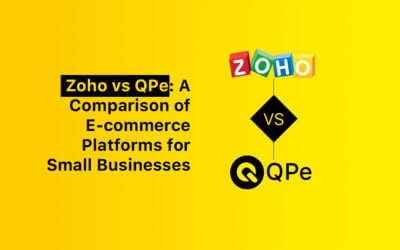Now, you can easily turn your passion into profit by starting your own clothing business. New brands can instantly reach customers worldwide, without any borders, thanks to the internet.
Despite the endless opportunities, many clothing ventures lose out on profits due to the usage of ineffective tools. That’s where e-commerce tools like Qpe come into the picture. With Qpe, you get everything you need to set up, grow, and scale your clothing brand seamlessly.
You don’t need any coding skills to create an online store on our platform. With QPe, new brands can reach customers everywhere and fulfill their outfit dreams.
By taking the right approach and using efficient tools, you can fast-track your growth and build a successful business.
Follow this guide on how to start a clothing business to build a fashion brand from scratch and grow it over time.
TL;DR – How To Start a Clothing Business
If you’d like a quick look, here’s how:
- Look for a gap in the market that you can fill
- Identify who will buy your clothes
- Develop skills in design and business
- Make a Business Plan
- Choose a Business Model
- Stay Updated on Trends
- Start Designing Your Clothes
- Launch Seasonal Collections
- Find a Reliable Manufacturer
- Build Your Brand Identity
- Set Competitive Prices
- Choose Sales Channels
- Promote Your Clothing Line
- Set Realistic Sales Goals
- Start Small, Then Expand
Let’s dive in now that you have learned the steps.

Clothing Industry Trends to Follow
The clothing industry keeps changing, and new trends shape what people want. Stay ahead by adapting to these changes. Let’s look at the trends and how they can help your brand.
- Travel Returns, So Does Fashion
Travel is set to surge in the coming years, with more people planning trips. Shoppers from the US are looking to buy clothes while traveling, so brands should offer styles suited for travel. - Focus on Customer Loyalty
Brands are focusing on building stronger connections. Digital ad costs have risen, and data regulations have tightened. As a result, brands are using storytelling to connect with customers. - Climate Action is Urgent
Fashion impacts the planet. More extreme weather is being experienced. Brands must cut emissions. Supply chains need to be stronger. - Factories Feel Pressure
Suppliers are struggling with fewer orders, and factories are operating less than before. Brands need to offer better support. - New Rules for Sustainability
Sustainability laws are becoming stricter with the EU leading the way. Brands must quickly adapt to these new regulations. - Emergence of Gen AI
Generative AI is growing in fashion. It helps with design and products. Few brands use it well yet. This is a chance for leaders.
- Real Influencers Rise
People want to buy from authentic creators. They don’t trust old influencers. Brands should work with new voices. - Outdoor Styles Go Mainstream
Active lifestyles are popular now. People want clothes that look good and work well. Outdoor-inspired fashion is in demand. - Economic Shifts Continue
The world economy is still rocky. The US and Europe may slow down. Growing economies show growth potential. Brands must stay ready to adapt.
Now, that you know what’s coming, let’s help you create a business plan for your clothing company.
Steps to Create a Clothing Brand Business Plan
A good business plan is important for starting your clothing brand. Follow these simple steps to build a strong foundation for your fashion business.
Start with a brief overview of your business
Describe the idea behind your clothing line.
- What inspired you to start?
- Highlight your goals and where you see the brand going.
- Mention any early achievements.
- Even small wins count.
- Keep it interesting.
Provide a quick background of your business
Explain how your brand started and what sets it apart.
- Give details about your business structure.
- Do you own it alone, or are you working with a partner?
- Describe your brand’s mission and values.
- How do you want customers to perceive the brand?
- Don’t forget to talk about your location and team members.
Understand who you’re selling to
Describe your target market.
- Are you aiming at young adults, professionals, or budget-conscious shoppers?
- Discuss fashion trends that matter for your business.
- Study your competitors.
- Know what they do well and where you can do better.
- Point out gaps your brand can fill.
- What unique value will you offer?
Outline what your clothing line offers
List your main products, such as casual wear, luxury pieces, or accessories.
- Explain the materials and features that make your products special.
- State your pricing.
- Make sure it fits your audience’s budget.
- Include plans for future collections or seasonal releases.
Show how you’ll promote your clothing line
Set clear goals.
- Are you focusing on brand awareness, direct sales, or both?
- Pick your channels – Social media, email, and events are good options.
- Share your brand message – What do you want customers to know?
- Outline ways to measure success – Track sales, website visits, or social media engagement.
Detail the logistics behind the scenes
Explain your production process, from design to manufacturing.
- Share how you’ll source materials and handle suppliers.
- Discuss inventory management.
- Balance stock levels to meet demand without overstocking.
- Describe the order fulfillment process, from sales to delivery.
Outline how you’ll manage your money
List the startup costs, such as production, marketing, and equipment.
- Explain how you’ll generate income – Will you sell online, in stores, or both?
- Share financial forecasts for the first few years.
- Be realistic about expected income.
- Mention your funding needs and sources. State how much you need to launch and grow.
Plan how you’ll expand over time
Look at adding new products, like seasonal items or accessories.
- Consider partnerships, collaborations, or influencer deals.
- Think about entering new markets.
- Could you sell in different regions? Use technology to support growth.
- An online e-commerce store or better tools for tracking sales can help.
After setting your clothing brand strategy, concentrate on keeping things steady and be ready to tweak it as necessary.

How to Start a Clothing Business
The process of starting a clothing business is exciting, and you can do it if you follow this simple guide.
Look for a gap in the market that you can fill
Many businesses struggle because they don’t solve a real problem. Research to make sure there’s demand for your products.
- Use Google Trends to identify popular items.
- Read competitor reviews to spot customer complaints.
- Check Facebook Analytics for audience interests and behaviors.
Identify who will buy your clothes.
Understand your audience, it will help you connect better and build a loyal customer base.
- Define demographics like age, gender, and location.
- Think about their hobbies, lifestyle, and shopping habits.
- Focus on how your products solve their problems.
Develop skills in design and business
This will help you create high-quality products and make smart business decisions.
- Take courses on platforms like Udemy or MasterClass.
- Join a fashion program at a college or design school.
- Work for established designers to gain hands-on experience.
Make a Business Plan
A well-thought-out business plan guides your decisions and helps attract investors. It outlines your brand’s goals and the steps needed to achieve them.
- Describe your brand’s mission and products.
- Set clear, achievable goals.
- Use market research to support your plans.
- Detail the steps to reach your business objectives.
Choose a Business Model
Decide how you’ll produce and sell your clothes. Each model has different benefits and challenges.
- DIY production: Make the products yourself and sell directly.
- Print-on-demand: Design items and let a service handle production and shipping.
- Manufacturing partnership: Partner with a manufacturer to produce your collections.
Stay Updated on Trends
Keep an eye on the latest fashion trends to stay relevant. By Knowing what’s popular will help you design products people want.
- Follow fashion influencers and read style magazines.
- Subscribe to newsletters that cover fashion news.
- Attend fashion shows and trade events for inspiration.
Start Designing Your Clothes
Create pieces that reflect your brand’s style and appeal to your audience. Focus on creativity, quality, and customer needs.
- Carry a sketchpad for new ideas.
- Use high-quality materials to ensure durability.
- Develop a tech pack with product details for manufacturers.
Launch Seasonal Collections
Introduce collections regularly, it keeps your brand fresh. Design clothes that match the seasons or specific themes.
- Offer light fabrics for summer collections.
- Add cozy pieces for winter.
- Create themes that align with your customers’ interests.
Find a Reliable Manufacturer
Choose the right manufacturer, it is crucial for quality and consistency. Research thoroughly to find a good fit.
- Compare local and overseas manufacturers.
- Search online directories or attend industry events.
- Ask questions and check reviews before making a decision.
Build Your Brand Identity
Create a strong brand identity that resonates with your audience. Your brand’s look should be unique and consistent.
- Design a logo and select a color palette.
- Maintain a consistent style across marketing materials.
- Take high-quality photos that show off your products.
Set Competitive Prices
Price your products fairly. Make sure your prices cover costs while staying attractive to customers.
- Factor in the cost of materials, labor, and overhead.
- Use pricing strategies like keystone markup.
- Adjust prices based on customer feedback and market trends.
Choose Sales Channels
Decide how and where you’ll sell your products. A mix of online and offline options can help you reach more customers.
- Sell on your own website and marketplaces like Etsy.
- Partner with local boutiques or shops.
- Set up a simple website to showcase your brand.
Promote Your Clothing Line
Marketing is key to getting noticed. Plan your strategy before you launch to create buzz and attract buyers.
- Use social media to share content and grow your audience.
- Run Facebook Ads to reach specific groups.
- Partner with influencers to increase brand visibility.
Set Realistic Sales Goals
Start with achievable targets and grow gradually. Avoid aiming too high too soon.
- Aim for steady growth, like a 20% sales increase each month.
- Monitor progress and adjust goals as needed.
- Stay flexible and adapt if things change.
Start Small, Then Expand
Test your products with a soft launch. This helps you gather feedback and refine your approach before scaling up.
- Introduce a smaller collection at first.
- Listen to customer feedback to improve your products.
- Look for investments or partnerships to help you grow.
It is now time to launch your clothing business. Stay focused, adapt to changes, and let your brand make its mark in the world of fashion.
Ways to Market a Clothing Brand
Marketing your clothing brand helps you connect with customers and stand out. Here are some practical ways to get your brand noticed.
Boost Your Social Media Game
Use social media to share your brand’s style and connect with followers. This helps build your audience and showcase your products. Post real-life photos from customers who wear your clothes as it feels more genuine. Partner with micro-influencers who share your brand values, such as sustainable fashion.
Host a weekly “Style Tip Thursday” where you share simple fashion advice using your products.
Improve Your Website Experience
A clean, user-friendly website encourages visitors to explore and buy your products. Use keywords like “affordable streetwear” in your product descriptions to reach a specific audience.
Create a “Style Inspirations” section where customers can discover curated outfits and styling ideas. Showcase different categories to help shoppers easily find items that fit their style.
Get Customers to Share Their Opinions
Customer reviews can build trust and give new buyers more confidence in your brand. Share a customer’s photo review with a caption like,”Looking fabulous, Sarah! Your take on our denim jacket is pure style goals. Thanks for sharing!”
Offer a discount on the next purchase for customers who leave a review. Respond to reviews with a personal touch.
Use Pinterest to Inspire and Sell
Pinterest is great for showcasing styles and reaching people looking for outfit ideas. Create a board for “Summer Essentials” featuring your dresses, sandals, and accessories.
Pin fashion trends with your products to appeal to people looking for that style. Share pins that show different ways to wear your products.
Share Content Created by Customers
User-generated content adds authenticity to your brand and encourages others to share. Repost a customer’s video on Instagram with the caption.
Feature customer selfies on your website’s homepage to show real people enjoying your products. Create a monthly post to highlight loyal customers and encourage others to participate.
Tell Your Brand’s Story Through Content
Content marketing helps share your message and connect with your audience on a deeper level. Write a blog post to share your brand’s mission.
Make a short video showing how your clothes are made, highlighting fair labor practices. Post on social media about your founder’s story, such as how they started the brand from their garage.
Get Your Brand Seen Locally
If you have a physical store or want to attract local customers, make sure they can find you online. Offer option for online orders to encourage nearby customers to shop.
Host a small event at your store, like a styling workshop, and promote it through local channels. Add tags to your online posts, appealing to customers who prefer supporting nearby businesses.
Try Paid Ads for Quick Results
Paid ads can help you reach a larger audience quickly. Make sure to target the right people. Use Facebook Ads to target people who recently searched for “casual wear” or “sustainable fashion.”
Create Google Ads to reach people looking for specific items. Promote a time-limited sale with Instagram Ads.
Bring Back Lost Customers with Retargeting
By retargeting ads reach people who showed interest but didn’t buy. Encourage them to come back. Show a retargeting ad with a message like “Still thinking about this? Get 10% off your cart.”
Create ads that highlight products recently viewed by the visitor. Send a reminder about items left in the cart with a small discount to complete the purchase.
Stay in Touch Through Email
Email marketing helps you keep your audience informed and engaged. It’s great for sharing news and special deals. Send a “Welcome Email” to new subscribers with a discount for their first purchase.
Share emails when a sale is ending soon. It encourages quick action. Feature customer stories in your newsletter to add a personal touch.
Host a Fun Giveaway to Create Buzz
Giveaways are a fun way to engage your audience and attract attention. Run a giveaway where followers can win a gift card or a featured product.
Offer a contest. Ask participants to pick their favorite items from your store. Collaborate with another brand for a combined giveaway to reach more people.
By incorporating these strategies, you will be able to grow your clothing brand and attract more customers. Adapt your marketing to ensure you remain competitive.
Future of Clothing Retail Industry: What’s Next?
In the future, things will change, but they will also be rewarding. Let’s find out how to reach a new audience with evolving tastes.
1. Reach Gen Z
Gen Z wants shopping to be easy. They buy wherever it works best for them—online or in stores. They switch between the two without any problem.
Recent numbers show that 56% of US Gen Z prefer to shop online rather than in-store. Make your online presence stronger to win here.
2. Shop with AR
AR and virtual shopping change the way people buy clothes. They make it more interactive and fun.
With AR, customers can try on outfits at home using their phones. This helps them pick the right size and reduces returns. Virtual shopping takes it even further:
- Explore digital dressing rooms to check out different looks.
- Get outfit ideas from AI stylists.
- Shop in virtual stores that feel like real shops.
This tech makes shopping smoother and better for the planet. It cuts down on returns and reduces the need for physical samples.
3. Millennials Choose Quality
Millennials, born between 1981 and 1996, look for quality. They prefer well-made, lasting clothes over quick trends.
To win them over, brands should:
- Use high-quality materials and classic designs.
- Be open about how they make their products.
- Focus on being sustainable and fair.
Social media matters too. Millennials want real connections with brands. Team up with genuine influencers and build a community around shared values. Avoid fake marketing and earn their trust.
The future of clothing retail is all about adapting to new trends and customer needs. Stay flexible and keep up with what younger shoppers want.
Best Website Builder For Online Clothing Store
Without a doubt, your new clothing business needs an online store to sell with no limits. A well-built e-commerce site lets you reach customers around the clock and provide a seamless shopping experience.
Largely, your store’s success depends on choosing the right website builder.
That’s the reason Qpe makes it simple to start an online clothing store. It’s affordable, easy to use, and packed with all the tools you need.
Why Choose Qpe?
- Quick Store Setup – Set up your store in minutes with no coding. Setup a domain, add products, customize, and go live.
- Stylish Themes – Over 100 themes optimized for sales and SEO. Get a custom theme if needed.
- Marketing Support – SEO tools for better rankings, social media integration, automated chatbots for customer engagement.
- Simple Product Management – Add and update products easily, use filters to help shoppers find items, manage orders and inventory effortlessly.
- Sell Everywhere – Sell on your website, social media, and marketplaces, and use the POS system for in-store sales.
- Global Reach – Multiple currencies and language support, manage international taxes seamlessly.
- Save on Tech Costs – All-in-one solution to lower expenses and boost profits.
- Customer-Focused Features – Recover abandoned carts, offer wishlist and loyalty points.
- Data-Driven Insights – Get reports on sales and customer behavior to make smart decisions.

Ready to launch your online clothing store? Get started with Qpe today and enjoy a seamless setup, powerful features, and all the tools you need to succeed. Build your store now and start selling without limits!
Frequently Asked Questions:
How Do You Source Material for a Clothing Line?
Look for fabric suppliers online or at local markets to find the materials you need. Check for quality, prices, and minimum order sizes before buying.
Can I Start a Clothing Business With No Experience?
Yes, you can start without experience by learning as you go. Use online courses, videos, and guides to help you get started. Focus on understanding your customers and building your brand.
What Are the Most Effective Ways to Market a New Clothing Brand?
Promote on social media and partner with influencers to get noticed. Run ads that target your audience and share interesting content. Create a simple website and use emails to keep in touch with customers.
How Do I Choose the Right Manufacturer for My Clothing Line?
Find a manufacturer known for good quality and service. Ask for samples to check the quality of their work before you decide. Compare prices, order sizes, and delivery times to pick the best one.



